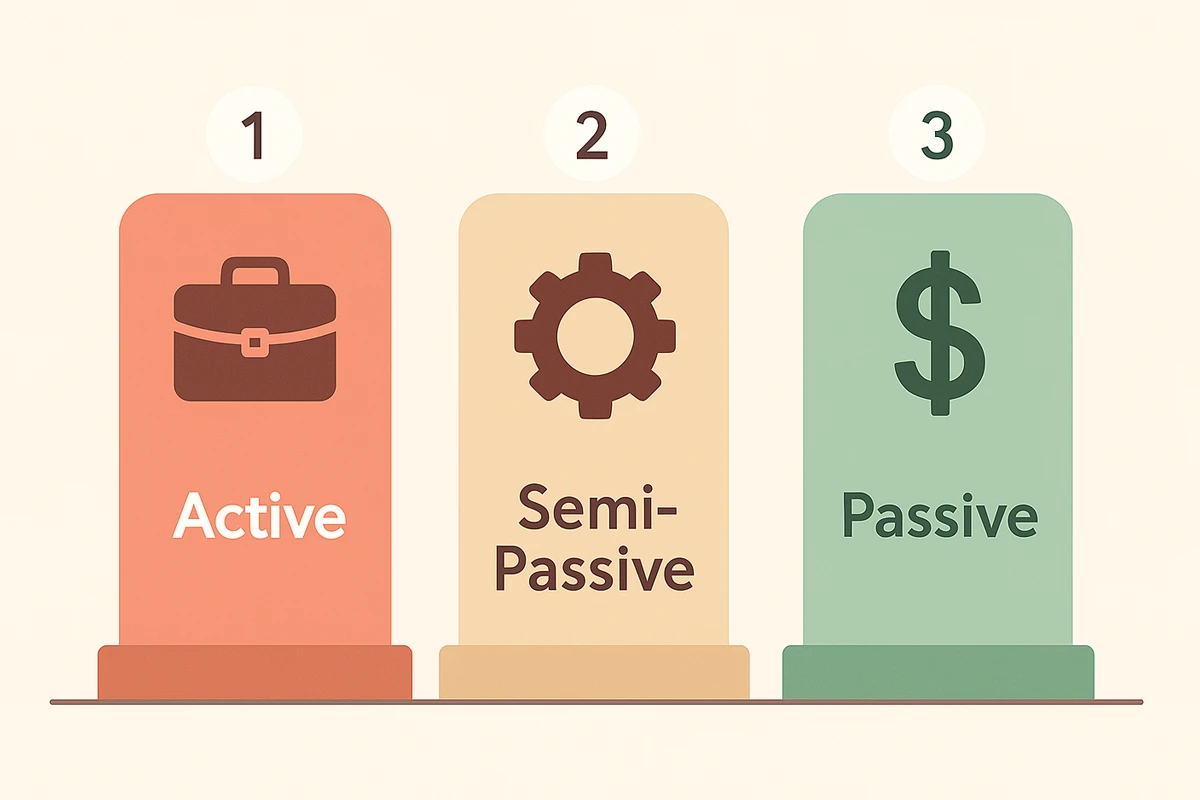One paycheck is a single point of failure. Lose it and your entire lifestyle flatlines. The wealthy refuse to gamble their family’s future on one employer or one product—they build multiple engines that spit out cash whether the economy is roaring or tanking. Imagine waking up to rent checks, dividend alerts, and digital product sales before you even pour coffee. That’s the security, autonomy, and explosive growth Law 21 unlocks—starting today.
What “Multiple Income Streams” Really Means

Plain-English Definition
Multiple income streams = money flowing to you from more than one independent source—salary plus side hustle, dividends, rental checks, digital royalties, etc. Each stream should be capable of surviving if another dries up. Think of them as parallel pipelines feeding the same reservoir: your net worth.
Cash-Flow vs. Asset Diversification
Asset diversification spreads your investments across stocks, bonds, real estate, and cash to lower market risk.
Cash-flow diversification spreads your paydays across different engines (work, business, investments) to lower lifestyle risk.
You need both, but cash-flow diversification keeps food on the table today, not just 30 years from now.
Analogy: Single-Engine Plane vs. Twin-Engine Jet
A single-engine plane flies fine—until the engine fails. A twin-engine jet can lose one motor and still reach the runway. Your job is the first engine; side ventures, passive investments, and automated businesses supply the backup thrust that keeps you airborne when turbulence hits.
Quick Litmus Test
Could you cover next month’s bills if your employer vanished?
Does any one client or platform account for over 50 % of your monthly income?
Are all your paydays fixed to your personal labor hours?
If you answered “yes” to any, it’s time to bolt on additional engines—before you need an emergency landing.
The Hidden Risk of a Single Paycheck

1. Layoffs can hit any industry—fast.
U.S.-based tech firms alone cut ≈ 95,000 jobs in 2024, and the layoff tracker keeps climbing in 2025. Add another 150,000+ public-sector and corporate cuts announced just this spring, and it’s clear no badge is bullet-proof. news.crunchbase.com/intellizence.com
2. Your “job security” window is shrinking.
The median employee tenure is now just 3.9 years (3.5 in the private sector). Translation: every four years, half the workforce is effectively starting from scratch. bls.gov
3. Inflation quietly taxes a single income.
Even in a “low-inflation” year, prices still climbed 2.4 % over the past 12 months—enough to erode any raise that doesn’t beat that pace. bls.gov
4. One employer = one point of failure.
A single paycheck ties your mortgage, groceries, and retirement contributions to one decision-maker (your boss) and one macro trend (your industry). When either wobbles, your entire lifestyle does too.
5. The mindset shift
Stop thinking “stable job,” start thinking “fragile engine.” Your goal in Law 21 is to bolt on additional engines—income streams that keep the plane aloft when turbulence hits.
The Three Pillars of Income

Pillar 1 — Active Income
Your hours = your dollars
Core Idea: You get paid only while you’re working—consulting, freelancing, shift work, overtime.
Time Required: High and ongoing. Clock out and cash flow stops.
Typical Payback Window: Same day to ≈ 30 days (fastest way to inject cash).
Scalability: Limited; capped by your calendar and energy.
Starter Examples: Freelance coding audits, weekend tutoring, ride-share driving, high-ticket sales calls.
Pillar 2 — Semi-Passive Income
Front-load effort, then coast on light maintenance
Core Idea: Build or buy an asset that earns while you sleep, but still needs check-ins.
Time Required: Moderate up-front; low ongoing (think a few hours a month).
Typical Payback Window: Roughly 3–12 months to recoup investment.
Scalability: Moderate; systems and small teams can multiply results.
Starter Examples: Dividend-growth stock portfolio, cash-flow blog with ads, rental arbitrage unit, a $49 video mini-course.
Pillar 3 — Passive Income
Capital or intellectual property works 24/7—no clock-punching
Core Idea: Deploy money, code, or creative IP that keeps paying you with almost zero babysitting.
Time Required: High up-front in cash or creativity; virtually none afterward.
Typical Payback Window: 1–5 years, but compounding is exponential.
Scalability: High; add more capital or IP and the flywheel speeds up.
Starter Examples: Broad-market index funds, royalties from an e-book, equity slice in a SaaS, REITs.
How to Use the Pillars
- Stack, don’t swap.
- Keep your active income as the fuel source while you build semi-passive and passive engines on the side.
- Sequence for momentum.
- Phase 1: Juice cash-flow quickly with an Active side hustle that leverages your highest-value skill (e.g., freelance software audits).
- Phase 2: Funnel those profits into a Semi-Passive project (e.g., launch a bite-size digital course or acquire a cash-flowing blog).
- Phase 3: Snowball excess cash into Passive vehicles that compound without your fingerprints (index funds, REITs, royalties).
- Audit quarterly.
- Check each stream’s:
- Net ROI (after taxes & expenses)
- Time cost per $1 earned
- Stress/complexity score (1–10)
- Anything scoring low ROI and high time or stress goes on the chopping block.
- Automate early.
- Use tools like Zapier, Stripe, and robo-investing platforms to strip out manual busywork the moment a stream turns predictable.
Key takeaway: Treat these pillars like engines on a jet. Active income gets you airborne, semi-passive handles cruising altitude, and true passive thrust lets you soar—even if the first engine flames out.
Match Your Strengths to the Right Stream

Step 1 — Build Your Skill-Inventory Matrix
- Skills
- What to list: Hard + soft skills you can monetize.
- Why it matters: Reveals what people will actually pay you for.
- Quick question: “What do coworkers always ask my help with?”
- Passions
- What to list: Topics you’d gladly research or talk about for fun.
- Why it matters: Fuels consistency once the novelty wears off.
- Quick question: “Could I riff on this for an hour—unpaid?”
- Capital
- What to list: Cash, tools, audience, or time blocks you can deploy.
- Why it matters: Dictates which startup routes are realistic today.
- Quick question: “How much money or time can I risk this quarter?”
- Risk Tolerance
- What to list: Your emotional + financial bandwidth for potential losses.
- Why it matters: Prevents paralysis or reckless bets.
- Quick question: “Would a $1k loss ruin my week—or my life?
Step 2 — Spot the Low-Hanging Fruit (LHF)
Overlap test: Circle items that show up under both Skills and Passions.
Leverage check: Ask, “Can I deliver this knowledge/service digitally?”
Fast path to cash: Rank each idea by days to first dollar. Anything ≤ 30 days is prime LHF territory.
Example:
• Skill: Advanced Excel dashboards
• Passion: Teaching bite-sized tutorials
• Capital: Laptop + Screen-record software (already owned)
• Risk tolerance: Low (won’t front big money)
→ LHF Idea: $29 mini-course on “90-Minute Excel Dashboards for Managers.” First sale possible in 7 days.
Step 3 — Apply the Hormozi 7-Day Money Test
“How can this generate actual revenue within one week?”
Strip the idea to its Minimum Viable Offer (MVO).
Pre-sell to three people (friends, LinkedIn, niche forum) before you build.
Deliver live via Zoom or a simple PDF—then iterate.
If it can’t pass the 7-day test, park it in the “long-term plays” list and focus on a faster engine.
Step 4 — Assign Each Idea to a Pillar
Active: Freelance audit on that skill
Semi-Passive: Recorded video course, paid newsletter
Passive: License IP, invest profits into index funds
Aim for one project per pillar before you chase shiny new streams.
Step 5 — Commit to a 30-Day Sprint
Choose the top LHF idea.
Block 10 focused hours per week on execution.
Ship v1 by Day 30—perfect later.
Remember: Multiple income streams aren’t built by dabbling in twenty ideas; they’re forged by shipping one engine at a time, stacking momentum, and reinvesting profits into the next stream.
Seven Proven Streams — Ranked by Effort 🆚 ROI

(Read this like a menu: pick what fits your appetite, budget, and bandwidth today—then add another dish next quarter.)
1. High-Yield Side Hustles (Consulting / Coaching)
Startup Cost: < $100 (Zoom + a Stripe account).
Payback Window: Same week—you can close your first client by Friday.
Effort: 🔥 Intense but short bursts; you’re trading expertise for dollars.
Scalability: Low unless you later package knowledge into group programs or courses.
Quick Win: DM five LinkedIn contacts offering a 90-minute “mini audit” for $297. Deliver live, record it, ask for a testimonial, repeat.
2. Digital Products & Mini-Courses
Startup Cost: $0–$300 (screen-capture software, Teachable/Gumroad).
Payback Window: 1–4 weeks if you presell before filming.
Effort: Medium upfront; near-zero upkeep once live.
Scalability: Very High—one video sells a thousand times.
Quick Win: Take your most common client question, turn the answer into a 60-minute video + worksheet, presell for $49 to your newsletter.
3. Affiliate & Content Marketing
Startup Cost: Domain + hosting (~$50/year) or a free Substack.
Payback Window: 2–6 months (SEO + list-building lag).
Effort: Consistent content grind; compounds with every post.
Scalability: High—the internet never sleeps, and links keep earning.
Quick Win: Publish a “Tools I Use” page, embed your best-paying affiliate links, and push it to Reddit/Facebook niche groups.
4. Real-Estate Cash Flow (REITs → Rentals → Syndications)
Startup Cost: REITs: $500. Rentals: 5–20 % down. Syndications: $25k+.
Payback Window: Dividends monthly/quarterly; equity gains long-term.
Effort: Low (REITs) to High (landlording).
Scalability: High if you systemize with property managers and 1031 exchanges.
Quick Win: Open a brokerage account, buy a diversified REIT ETF, and reinvest dividends automatically.
5. Dividend-Growth Investing
Startup Cost: Whatever you can auto-transfer from each paycheck.
Payback Window: Quarterly dividends begin instantly; serious snowball ~3 years.
Effort: Minimal—set and forget.
Scalability: Infinite; compounding does the heavy lifting.
Quick Win: Automate $200 bi-weekly into a dividend-aristocrat ETF—reinvest and ignore until your statements shock you.
6. Automated E-Commerce (Print-on-Demand)
Startup Cost: <$50 (Shopify basic + Canva). Inventory = $0.
Payback Window: 1–3 months once a design catches fire.
Effort: Medium upfront (store setup, design); low maintenance after automation.
Scalability: High—winning designs scale with ad spend or influencer shout-outs.
Quick Win: Launch three meme-based T-shirt designs on Etsy, connect Printful, and test keywords with $5/day ads.
7. Peer-to-Peer Lending & Royalties
Startup Cost: $100–$1,000 tickets in platforms like LendingClub or licensing your digital assets.
Payback Window: 3–5 years for loan cycle / royalty tail.
Effort: Lowest—money or IP works entirely on autopilot.
Scalability: Moderate; returns plateau unless you keep reinvesting.
Quick Win: Upload that e-book/preset pack sitting on your hard drive to Gumroad and flip “Public” today.
How to Use This List
Pick ONE that matches your current time + capital profile.
Commit 30 focused days (see Section VI) to hitting first cash.
Automate or delegate the maintenance, then circle back for the next stream.
Remember: Streams become rivers when you stack, automate, and reinvest—not when you juggle seven shiny objects at once.
30-Day Launch Blueprint

From zero to first dollar—in four focused sprints.
Week 1 — Validate & Pre-Sell (Days 1-7)
Laser-focus on ONE stream. Pick the idea that checks “Fastest to Cash” in your Skill-Inventory Matrix.
Define the Minimum Viable Offer (MVO). What is the absolute smallest result you can deliver within a week? (e.g., 60-minute live audit, five-page guide, beta access to a Notion template).
Price it immediately. Anchor at transformational value, not hours worked—then slash anxiety by offering a 100 % “didn’t help, don’t pay” guarantee.
Pre-sell to three real humans.
DM warm leads on LinkedIn/Twitter.
Post a value bomb in one niche group, end with a CTA (“DM me ‘DASHBOARD’ for details”).
Collect payment via Stripe link.
Goal: Lock in at least $300 in commitments before you build a thing.
Week 2 — Build the MVP & Deliver First Win (Days 8-14)
Block two deep-work sessions (90 min each) to create only what you pre-sold. Forget logos, funnels, or perfect design.
Deliver fast. Hop on Zoom, ship the PDF, or grant access to the Notion doc.
Capture testimonials on the spot. Ask: “Mind giving me two sentences on what changed for you?”
Iterate v1 → v1.1 based on their feedback (clarify steps, add a checklist, tighten messaging).
Goal: Deliver tangible results and collect at least one killer testimonial.
Week 3 — Systemize & Automate (Days 15-21)
Record & repurpose. Turn your live delivery into evergreen assets—screen-record the walkthrough, slice the Q&A into micro-clips, convert notes into a swipe-file PDF.
Set up lightweight fulfillment:
Gumroad / Podia for auto-delivery.
Zapier → Email list tag + spreadsheet log.
Calendar booking link for upsell consults.
Template everything. Draft canned responses for FAQs, refund requests, and onboarding emails.
Goal: Be able to fulfill the next 10 sales on autopilot with zero live effort.
Week 4 — Scale & Promote (Days 22-30)
Turn on evergreen lead magnets.
3-part email mini-series that ends in your MVO offer.
One “how-to” blog/video with CTA at the 30 % and 90 % marks.
Publish social proof. Drop those testimonials everywhere—landing page, product banner, LinkedIn carousel.
Test a paid-traffic spark ($50).
Target one interest keyword on Facebook/Instagram or run a YouTube pre-roll.
Watch CPM vs. CTR; kill losers after 48 h.
Measure & tweak. Track CAC, conversion rate, and ROI in a simple Google Sheet. Double down on the top channel.
Goal: Hit $1,000 total revenue and prove strangers (not just friends) will buy.
After Day 30 — Rinse, Stack, Reinvest
Automate 80 % of this stream with SOPs or a VA.
Reinvest 50 % of profits into the next pillar (semi-passive or passive).
Repeat the blueprint—each new engine spins up faster with the assets, audience, and cash you just earned.
Remember: Momentum loves focus. Nail one engine in 30 days, automate it, then move to the next. That’s how streams compound into rivers—and rivers into real freedom.
Common Pitfalls & How to Dodge Them

Pitfall | Why it Happens | Rapid-Fix Playbook |
Shiny-Object Syndrome | New ideas feel more exciting than finishing current ones. | Lock into a single 30‑day sprint; Park new ideas in a “Next‑Quarter” Trello list—revisit only after current engine is automated. |
Over-Leveraging Debt | Cheap credit tempts you to scale faster than real cash flow. | Cap leverage at ≤ 35 % of total income until the stream is > 12 months old and proven; If you swipe a card, attach a clear ROI calculator and payoff plan. |
Neglecting the Core Cash Engine | Side projects cannibalize the bread‑and‑butter paycheck. | Schedule “Core Income First” hours each morning; Automate or outsource only after consistent profitability. |
Data Blindness | Building by gut instead of metrics—can’t spot bleed points early. | Track the 3 KPIs that matter: CAC, LTV, hours‑per‑$ earned; Review every Sunday and color‑code red/yellow/green. |
Burnout & Context Switching | Too many roles, no boundaries between work and life. | Time‑block by mode (deep work, meetings, creative); Insert a 10‑minute reset ritual (walk, stretch) between modes. |
Tax Surprises | Forgetting that Uncle Sam wants a slice of each new stream. | Funnel all side income into a dedicated account and auto‑transfer 25‑30 % into a Tax Stash; File quarterly estimates on Jan 15, Apr 15, Jun 15, Sep 15. |
Platform Risk | Entire stream tied to one algorithm or marketplace. | Mirror content to a backup platform and collect emails from day one; Run a yearly platform‑dependence audit—no single gatekeeper should control ≥ 50 % of revenue. |
Analysis Paralysis | Endless research equals zero execution. | Impose a 48‑hour rule: make the smallest reversible decision, then iterate; Remember: “Version 1 is better than Version None.” |
Bottom Line: Spot these traps early, deploy the rapid-fix playbook, and keep momentum rolling toward your next income engine.
Conclusion — Your Future: Powered by Many Engines
One paycheck is fragile. Two paychecks are insurance. Five, ten, or more?—that’s freedom.
The moment you bolt a second income stream onto your life, you’re no longer one HR email away from panic. Every additional engine widens the gap between surviving and thriving. It’s the difference between hoping you keep your job and knowing your cash flow works harder than you do.
So here’s the mission briefing:
Pick one low-hanging idea today—the one that can earn its first dollar fastest.
Run the 30-day sprint, automate, then reinvest the profits.
Stack the next engine. Repeat until your living expenses are paid by assets, not alarm clocks.
Because the richest version of you isn’t working harder; he’s (or she’s) working smarter—powered by multiple income streams that never clock out. See you on the inside.









